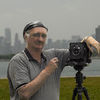Manual Mode on a Nikon D7100
Oct 24, 2018 08:40:14 #
Forgot to say that for fill flash, you need to set for the ambient light and set the flash accordi fly below
It's in the book!
It's in the book!
Oct 24, 2018 09:18:04 #
As stated above you need to stay at a SS of 1/250 or less (sync speed on the D7100) It will likely mean a lower ISO outside on a relatively bright day. My way is to shoot in A mode and 100 ISO, or lowest possible, change the aperture until you are under 1/250 sec. If you have really fast lenses and are going for shallow depth of field at large aperture openings you can find yourself unable to stay under 1/250. One shutter curtain will block the light of the flash at speeds above 1/250 but it may not be too noticable in really bright light. Some cameras sensing a flash through dedicated contacts won't even allow the shutter to release over 1/250 sec. BTW, the light meter still exists in almost all cameras, now just looks different. Here is a video showing the light meter: https://www.youtube.com/watch?v=4X993aqAkBY
Oct 24, 2018 09:18:13 #
In the bottom of the viewfinder in manual mode you will see the meter mode, adjust it till the small arrow is centered.
Oct 24, 2018 09:50:28 #
dennis2146 wrote:
You are correct. Put the camera in Manual mode and basically use the Sunny 16 rule. Once you use Manual mode for a while it begins to get easier.
Dennis
Dennis
No, there is a digital equivalent to the needles, usually visible in both the viewfinder and the screen.
Oct 24, 2018 09:51:43 #
Bubbee wrote:
Forgot to say that for fill flash, you need to set for the ambient light and set the flash accordi fly below
It's in the book!
It's in the book!
I love your screen name. Bubbees are the best!
Oct 24, 2018 11:45:58 #
James Reid wrote:
In the bottom of the viewfinder in manual mode you will see the meter mode, adjust it till the small arrow is centered.
This might not work be depending on what the cameras meter is reading. In other words if you set the exposure meter to center and then flash the scene you will be over exposed.
Oct 24, 2018 12:09:36 #
I have a Nikon D7100 and shoot manual mode with auto ISO. I guess you are familiar with DOF and so on. You can search “Steve Perry” on YouTube . He has a very instructive video on M mode with auto ISO.
Try it out..you will love it!
Try it out..you will love it!
Oct 24, 2018 12:49:18 #
If I understand your question correctly it's not so much how to do manual mode, but more why you are getting blown out or dark shots when using your flash with the camera in manual mode? Is that a safe statement? If so, what you are faced with is a little more complex than just understanding using manual mode with flash. Also, questions like the following need to be considered:
1) how is your meter set? matrix? spot? etc
2) ambient light conditions vary greatly, and you need to be smarter in making adjustments than the internal meter
3) conditions vary as far as what you want the flash to do, Fill? stop action? Settings for these on the camera and the flash are very
different
4) distance to the subject and flash power adjustments are a major consideration that you need to understand
5) bounce or direct flash? hard light? soft light?
Remember, when using flash (or strobes) you are dealing with 2 light sources contributing to the final exposure. For outdoor shooting in decent ambient light, a good rule of thumb is around having ambient light provide around 70-80% of the light with flash being 20-30% of the overall exposure. This will take some practice and understanding. A good starting point for outdoor shots (portraits, etc) would be to underexpose the ambient slightly and put your flash on half power, and see what you get and adjust accordingly. Remember, flash distance to the subject is critical. Light falls off very quickly, so if it worked at 5 feet from the subject, it won't work if you move to 10 feet from the subject and keeping all the settings the same. Practice, practice, practice :)
1) how is your meter set? matrix? spot? etc
2) ambient light conditions vary greatly, and you need to be smarter in making adjustments than the internal meter
3) conditions vary as far as what you want the flash to do, Fill? stop action? Settings for these on the camera and the flash are very
different
4) distance to the subject and flash power adjustments are a major consideration that you need to understand
5) bounce or direct flash? hard light? soft light?
Remember, when using flash (or strobes) you are dealing with 2 light sources contributing to the final exposure. For outdoor shooting in decent ambient light, a good rule of thumb is around having ambient light provide around 70-80% of the light with flash being 20-30% of the overall exposure. This will take some practice and understanding. A good starting point for outdoor shots (portraits, etc) would be to underexpose the ambient slightly and put your flash on half power, and see what you get and adjust accordingly. Remember, flash distance to the subject is critical. Light falls off very quickly, so if it worked at 5 feet from the subject, it won't work if you move to 10 feet from the subject and keeping all the settings the same. Practice, practice, practice :)
Oct 24, 2018 13:10:18 #
Oct 24, 2018 13:42:47 #
Leitz
Loc: Solms
autofocus wrote:
If I understand your question correctly it's not s... (show quote)
According to the original post, kb6kgx didn't recognize his meter display. Nothing was said about flash exposure problems. At least that's the post I read.
Oct 24, 2018 14:08:19 #
Leitz wrote:
According to the original post, kb6kgx didn't recognize his meter display. Nothing was said about flash exposure problems. At least that's the post I read.
but, he went on to say, " I’ve seen many of my shots either way too dark or washed out, and I don’t know why." and this was related to using flash. Reading the meter scale with it's +'s and -'s on the bottom of the screen should be pretty obvious, I would imagine. His concern seemed to be with getting blown out, or too dark images when using the flash.
Oct 24, 2018 17:56:24 #
Leitz
Loc: Solms
autofocus wrote:
but, he went on to say, "I’ve seen many of my shots either way too dark or washed out, and I don’t know why." and this was related to using flash. Reading the meter scale with it's +'s and -'s on the bottom of the screen should be pretty obvious, I would imagine. His concern seemed to be with getting blown out, or too dark images when using the flash.
Interpret it as you wish.
Oct 24, 2018 18:04:38 #
Leitz wrote:
Interpret it as you wish.
yes, I will, and knowledge not shared is only wasted, and whether it benefits him, or not, is unclear, but it just may help someone else
Oct 24, 2018 20:01:07 #
You may want to experiment when shooting manual on a bright sunny day...keep the exposure graph slightly on the minus side, the colors come out a lot richer.
Oct 25, 2018 01:34:09 #
kb6kgx
Loc: Simi Valley, CA
RWR wrote: You’re wise to learn manual exposure - there are situations where auto just doesn’t cut it.
You’re wise to learn manual exposure - there are situations where auto just doesn’t cut it.
 You’re wise to learn manual exposure - there are situations where auto just doesn’t cut it.
You’re wise to learn manual exposure - there are situations where auto just doesn’t cut it.I NEVER use "full auto", but mostly Aperture Priority. I also shoot a lot of helicopters and propellor aircraft so I also started using Shutter Priority so that I can keep the shutter speed constant for the right amount of prop/rotor blur. But I can do the same in Manual. I believe that Manual would be easy for me since my first SLR was a Nikon F, and the camera I had before that was an Agfa-Karat, which didn't even have a built-in light meter.
If you want to reply, then register here. Registration is free and your account is created instantly, so you can post right away.






